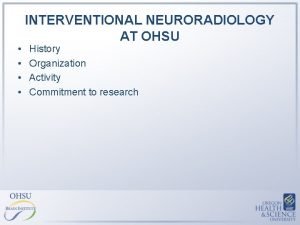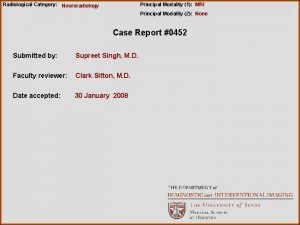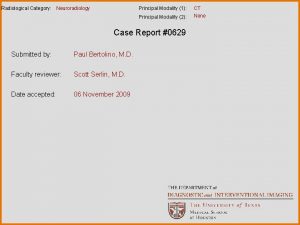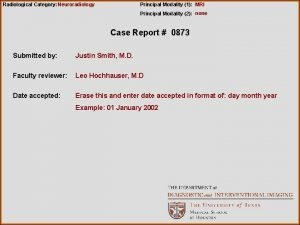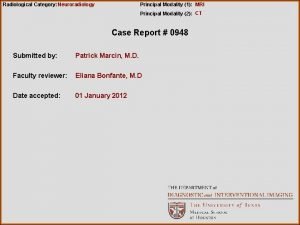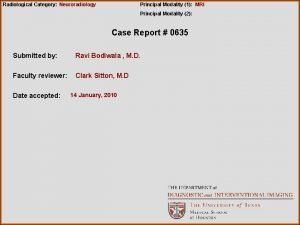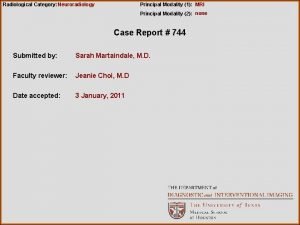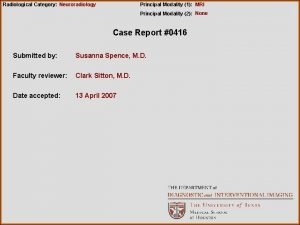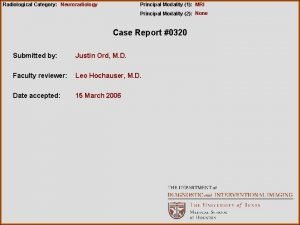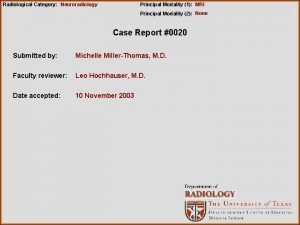Radiological Category Neuroradiology Principal Modality 1 MRI Principal











- Slides: 11

Radiological Category: Neuroradiology Principal Modality (1): MRI Principal Modality (2): none Case Report 0956 Submitted by: Justin G Smith, MD Faculty reviewer: Emilio Supsupin, MD Date accepted: 15 January 2013

Case History 12 day old Hispanic female • Presented to LBJ ER with tachycardia, hypotension, hypotonia, and suspected sepsis • History of poor oral intake and fussiness since birth • Blood, urine, and CSF cultures were negative. • Patient continued to have waxing and waning responsiveness and hypotonia.

MRI Brain: DWI and ADC

MRI Brain: DWI and ADC

Test Your Diagnosis Which one of the following is your choice for the appropriate diagnosis? After your selection, go to the next page. • Hypoxic Ischemic Injury (HII) • Maple Syrup Urine Disease

Pertinent Laboratory Findings Newborn Screen: Valine: Leucine: 271. 1 (upper limit 242) 451. 6 (upper limit 142) Urinalysis: (+) Protein & ketones

Findings and Differentials Findings: Bilaterally symmetric restricted diffusion is present in the following regions of the brain: peri-Rolandic white matter, corticospinal tracts including the posterior limbs of the internal capsules, globi pallidi with relative sparing of their ventral portions, ventromedial thalami, cerebral peduncles with particular involvement of the white matter tracts, midbrain, pons, brainstem, and deep white matter of the cerebellum. Diffusion restriction of the upper cervical spinal cord sparing its ventral portion is noted (not shown). Differentials: • Hypoxic Ischemic Injury (HII) • Maple Syrup Urine Disease

Discussion • Maple Syrup Urine Disease (MSUD) is a rare autosomal recessive disorder caused by decreased activity of the enzyme branched-chain alpha ketoacid dehydrogenase (BCKD) leading to increased blood levels of the branched chain amino acids (BCAA) leucine, isoleucine, and valine. • General population frequency is 1: 200, 000 live births although this can be as high as 1: 200 in certain Menonite populations. • Within 48 hours of birth, untreated infants will develop ketonuria, lethargy, and dystonia. By 4 days of life, neurologic signs become apparent to include: apnea, alternating lethargy/irritability, seizures, and signs of encephalopathy. • Diagnosis of MSUD can be performed using a urine sample assessing elevated branched chain ketoacids or elevated blood levels of the BCAAs. PCR testing for the genetic mutation is ultimately the gold standard. The Radiologist, however, may be first to suggest the diagnosis based on the classical pattern of cytotoxic edema and restricted diffusion on brain MRI.

Discussion • Two types of edema may be found on imaging. Initially there may be diffuse white matter brain edema evidenced by T 2 hyperintensity as well as diffusion restriction. It should be noted that this edema pattern will still demonstrate classical involvement of the cerebellar and brainstem white matter greater than the supratentorial brain. The more classical pattern involves the cerebellar white matter, dorsal pons, posterior brainstem, cerebral peduncles, posterior limb of internal capsule, and the posterior centrum semiovale. • Current evidence suggests the hypothesis that MSUD leads to impairment of energy production (mitochondrial injury) leading to intracellular cytotoxic edema and possibly cell apoptosis. This allows for effective use of DWI and ADC mapping to diagnose and follow neurologic injury. • The pattern of edema and diffusion restriction help differentiate MSUD for hypoxic ischemic injury (HII). HII does not have the infratentorial involvement of the white matter in the brainstem and cerebellum as classically seen in MSUD. It may have variable patterns of edema but will often involve the deep gray matter (commonly the ventrolateral thalamus), corticospinal tract, and the deep sulcal portion of cortical gray matter.

Diagnosis Maple Syrup Urine Disease

References Cavalleri F, et al. Diffusion-weighted MRI of maple syrup urine disease encephalopathy. Neuroradiology Jun 2002 44(6): 499 -502 Morton DH et al. Diagnosis and treatment of maple syrup disease: a study of 36 patients. Pediatrics. 2002 109(6): 999 -1008
 Ohsu neuroradiology
Ohsu neuroradiology Aerohive erate
Aerohive erate National radiological emergency preparedness conference
National radiological emergency preparedness conference Radiological dispersal device
Radiological dispersal device Tennessee division of radiological health
Tennessee division of radiological health Center for devices and radiological health
Center for devices and radiological health Mri principal
Mri principal Modality erd
Modality erd Data modeling fundamentals
Data modeling fundamentals Modality in software engineering
Modality in software engineering Birad
Birad Pacs modality workstation
Pacs modality workstation
